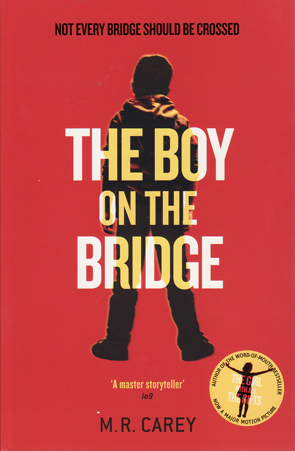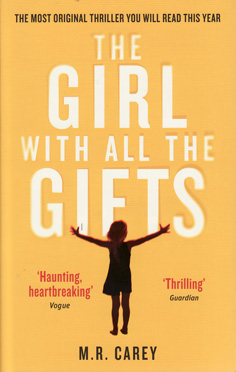The Boy on the Bridge is a prequel to The Girl with All The Gifts and is written with all the same pace and tension of the original. The premise of this novel is simple: the book takes the question of the Rosalind Franklin – the armoured mobile lab the characters find in London near the end of the first book – and tells us the story of how it came to be there. At first, I thought this would make the book a little predictable. Like in Rogue One from the Star Wars films, I assumed I could predict the ending. In Episode 4 of Star Wars we are told the Death Star plans are bought at the cost of many lives, so the idea that the characters of Rogue One were on a suicide mission was on my mind as I first watched that film. You could be forgiven for thinking the same of this book, but I found the story still had some final twists to offer, nevertheless.
But how satisfying was this ending? Without giving anything away, it was a question I felt bound to ask, since it is also about the success of the book as a whole. I had acquired a copy of Colm McCarthy’s film adaptation of The Girl with All the Gifts while reading this book. The movie is faithful to the novel throughout. I thought the book made a reasonably good film, but I hated the ending, which not only seemed unrealistic and trite, but was wrong for the character of Helen Justineau. Surely this wasn’t how Carey had ended his first book, I thought. I had remembered other aspects of the story. But sure enough, shoehorned into the last two pages is the ending I saw in the movie. Then I finished this book this morning and the experience of the movie last night made me more critical of Carey’s ending to The Boy on the Bridge. The ending provides a strong link to the original book – okay, one spoiler, Melanie, the ‘girl’ from the original book appears at the end of this story – but given the way everything had happened so far, the denouement seemed unnecessarily optimistic, much like the end of Cormac McCarthy’s The Road, which is one of the best post-apocalyptic books I’ve read, but the ending seems a strained and unrealistic attempt to leave the reader with hope.
This novel begins with the Rosalind Franklin leaving Beacon for its expedition north to take samples from the ‘hungries’, those humans now acting as hosts for the cordyceps fungus that has all but wiped out humanity. On board is a group of scientists and military personnel acting as their armed escort. The mission has been given two commanders, Dr Alan Fournier, an indecisive and ineffectual civilian commander and nominally in charge of the scientific mission, and Colonel Isaac Carlisle, a veteran of the flaming of civilian populations in a desperate attempt to control the spread of cordyceps. He’s one of the highest ranking military men left, and he has a pragmatic and careful approach to his mission and the welfare of his team.
Also on the expedition is Dr Samrina Khan and Stephen Greaves. Khan was with Colonel Carlisle when he led a group out of London to the relative safety of Beacon. During their retreat they rescued Greaves, then only a small boy, from a massacre on a bridge in which his companions were rapidly overcome by hungries. Greaves seems withdrawn and broken, without formal qualification like the rest of the scientific team. But he proves to have a formidable intellect, with an eidetic memory and a deep understanding of science, having been tutored by Dr Khan herself. Khan has adopted Greaves as a surrogate son, since his inability to relate to others is not only the product of his horrific experience, but due to a level of autism. Unlike the other members of the scientific group who act as a team under the protection of Carlisle’s military grunts, Greaves prefers to work alone, stealing out to study the hungries close up. It’s dangerous, but his methods reveal insights into the hungries’ behaviour, and his invention of e-blocker, the cream that prevents hungries smelling humans, at least makes him nominally qualified for the mission. Dr Khan, on the other hand, faces problems of her own. She has broken mission protocol with another mission scientist, John Sealey, and she finds at the beginning of the book that she is pregnant.
The Boy on the Bridge has all the same atmosphere and pace of the original, and Greaves’s connection with Khan provides the student/teacher relationship of Melanie and Helen Justineau of the original story. There is also the perplexing problem of the children infected with cordyceps who retain human qualities, which appear in the latter part of The Girl with All the Gifts. They are more central to this plot. However, the book does not have a lot new to offer the reader. Like the original, the plot centres around fight and flight, but the questions of humanity it raises have already been explored, and what this book does, instead, is offer more of this world and accompanying action. But the second time around, this isn’t quite as compelling if one’s interest is in the speculative possibilities of science fiction. The focus here, Greaves’s fascinating mental deliberations notwithstanding, is action and politics. And while the political intrigues that are revealed in the plot involving the members of the mission and the events taking place back at Beacon may be a reflection of human nature in themselves, as a central focus of the book, it somewhat misses the speculative potentials of the story. Instead of the frightening potentials of nature or the hubris of science, I think the thematic concerns of the novel are diminished, especially since they focus more on the morality surrounding the following orders – a key concern for Carlisle – and therefore connected to the political backdrop of the story, rather than the wider implications the story is predicated on. Lieutenant McQueen is demoted for not following orders, Carlisle is haunted by the orders he followed when firing London and the mission is compromised by conflicting and secret orders. Carlisle tells McQueen that part of their function is to obey even when they don’t entirely understand.
McQueen replies, That shouldn’t be part of anybody’s function.
In this iteration of Carey’s world, humanity is defined by choice – the choice to make decisions, not follow blindly, not act instinctively – but that seems to be the summative conclusion of the speculative potential of the story.
I think this book fell short. I think I would have admired it more had Carey fleshed out the philosophical potential of his world more directly; about where our humanity lies, for instance, rather than adopting a simple morality. But anyone who liked the first book should enjoy this book just as much for its world, the characters, the tense situation and the blanks it fills in. This was an enjoyable, fast read, even if it could have done more.

 RSS Feed
RSS Feed Facebook
Facebook Instagram
Instagram YouTube
YouTube Subscribe to our Newsletter
Subscribe to our Newsletter




No one has commented yet. Be the first!